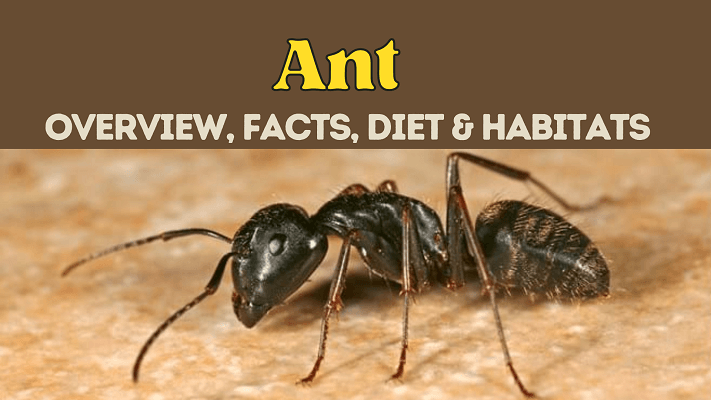Ant | Overview, Facts, Diet & Habitat
Home » Animals » Ant | Overview, Facts, Diet & Habitat
Ants a social insects known for their colonies, organized hierarchy, and cooperative behavior, playing vital roles in ecosystems worldwide.
Ant Overview
Appearance
Ants are small insects with six legs and a distinct segmented body. They typically have a hard exoskeleton, often in shades of brown or black, and some species may display various patterns or colors. Ants possess powerful mandibles used for carrying food, defending their colony, and constructing nests.
They have two antennae that aid in communication and sensing their environment. Their size can vary depending on the species, ranging from a few millimeters to several centimeters in length.
Origins And Evolution
Ant is believed to have evolved from wasp-like ancestors during the mid-Cretaceous period, around 110 million years ago. Their evolutionary path led to the development of a social lifestyle centered around complex colonies.
Over time, ants diversified into numerous species, adapting to various ecological niches and forming intricate caste systems for specialized tasks. This evolution was driven by natural selection favoring traits that enhanced cooperation, communication, and division of labor among colony members.
Today, ants are a highly successful and diverse group of insects, showcasing the remarkable results of their long evolutionary journey.
Behavior and Lifestyle
Ants are highly social insects known for their intricate behaviors and organized lifestyles. They live in colonies structured around a queen, worker ants, and sometimes soldier ants.
Through pheromone communication, ants coordinate tasks such as foraging, nest building, and defense. They exhibit a complex division of labor, with workers specializing in roles like food gathering, caring for the young, and colony maintenance.
Ants also practice agriculture, cultivating fungi or herding aphids for food, showcasing their remarkable adaptability and cooperative behavior.
Scientific Classification
- Kingdom: Animalia
- Phylum: Arthropoda
- Class: Insecta
- Order: Hymenoptera
- Family: Formicidae
Locations
- Forests
- Grasslands
- Deserts
- Wetlands
- Urban areas
- Agricultural fields
- Coastal regions
- Tropical rainfore
Fast Facts
- Name: Ant
- Scientific Name: Formicidae (family), within the order Hymenoptera
- Habitat: Ants are found worldwide, inhabiting various ecosystems including forests, grasslands, deserts, and urban areas.
- Diet: Ants have diverse diets, ranging from scavenging on dead insects to hunting other insects and tending aphids for their honeydew.
- Physical Features: Ants typically have a hard exoskeleton, six legs, and a segmented body. Their color varies but is often shades of brown, black, or reddish. They have two antennae used for communication and sensing their environment.
- Nocturnal: While some ant species are more active at night, most ants are diurnal (active during the day).
- Solitary: Ants are highly social insects and live in colonies with organized caste systems, including queens, workers, and sometimes soldiers.
- Unique Order: Belong to the order Hymenoptera, which also includes bees and wasps.
- Lifespan: Ant lifespans vary greatly by species. Worker ants typically live a few weeks to a few years, while queens can live for several years.
- Conservation Status: as a group, are not typically assessed for conservation status.
- Fun Facts: Leafcutter ants are known for cutting and carrying leaf fragments back to their nests to use as substrate for cultivating fungus.
Ant Physical Characteristics
- Color: Varied (typically brown, black, or reddish).
- Skin Type: Exoskeleton.
- Top Speed: Up to 0.03 m/s (0.1 ft/s).
- Lifespan: A few weeks to several years.
- Weight: Varies by species (ranging from 1 mg to a few grams).
- Length: Varies by species (ranging from a few millimeters to several centimeters).
- Age of Sexual Maturity: A few weeks to months.
- Age of Weaning: Varied (usually shortly after the pupal stage).
FAQs
What are ants?
Ants are social insects that live in colonies and are known for their organized behaviors, division of labor, and complex communication systems.
How do ants communicate?
They communicate using pheromones, chemical signals that convey information about food sources, danger, and other colony activities.
Why do ants form colonies?
Colonies provide a way for ants to work together, share resources, and increase their chances of survival and reproduction.
What do ants eat?
They have diverse diets, including scavenging for dead insects, nectar from plants, and in some cases, farming fungi or herding aphids for honeydew.
Are all ants the same size and color?
No, they come in various sizes, colors, and shapes, depending on the species.
Do ants have a queen?
Yes, most colonies have a queen whose primary role is to lay eggs and ensure the survival of the colony.
Can ants sting or bite?
Yes, some ant species have stingers that can deliver painful stings, while others can bite as a form of defense.
How long do ants live?
The lifespan of ants varies by species, with worker ants typically living for a few weeks to a few years, while queens can live much longer.
Why do ants carry food and other objects back to the colony?
They carry food to the colony to feed other members and the developing larvae. They also store food for times when resources are scarce.
Do ants have any ecological significance?
Yes, they play important roles in ecosystems as predators, scavengers, seed dispersers, and soil aerators.
Related:
- Tarantula
- Mackerel
- Mackerel
- Sea Stars
- Bird
- Amphibians
- Vertebrates
- Sand Dollars
- Barnacles
- Scallop
- Brittle stars
- Tilapia
- Carp
- Krill
- Catfish
- Grouper
- Calm
- Yak
- Yucatan Brown Brocket
- White-tailed Deer
- Uakari
- Utahraptor (Dinosaur)
- Qinghai Lake Naked Carp
- Qilian Shrew
- Qinling Panda
- Qacha’s Nek long-fingered Frog
- Red Fox
- Red Panda
- Rockhopper Penguin
- Salamander
- Snail
- Storks
- Jacana
- Junglefowl
- Jabiru Stork
- Junco
- Japanese Crane
- Kudu
- Kingfisher


